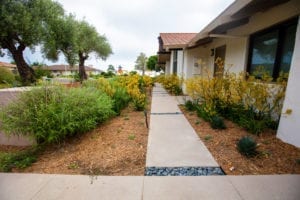Los Angeles, often referred to as the “City of Angels,” is renowned for its pleasant Mediterranean climate and diverse landscapes. It’s no surprise that many residents and landscape enthusiasts in Los Angeles turn to decomposed granite (DG) to create beautiful and functional home gardens. DG has gained immense popularity due to its versatility, eco-friendliness, and cost-effectiveness.
In this comprehensive guide, we’ll explore the various types of decomposed granite available in Los Angeles and provide step-by-step instructions on how to install it effectively.

What is Decomposed Granite?
Decomposed granite is a natural and weathered type of rock that has eroded over time, breaking down into smaller pieces and particles. It is primarily composed of granite, an igneous rock that contains minerals like quartz, feldspar, and mica. DG is known for its attractive appearance and permeable qualities, making it an ideal choice for landscaping projects in Los Angeles.
Types of Decomposed Granite
In Los Angeles, you can find several types of decomposed granite, each with its unique qualities. The choice of DG type largely depends on your specific landscaping needs and aesthetic preferences. Here are the most common types:
1. Natural Decomposed Granite (Loose DG)
This is the least expensive type of DG, consisting of granite aggregates without any additives. Also, it is commonly used in landscapes for mulching, patios, garden paths, and play areas. Besides, natural DG is an excellent non-organic mulch and provides nutrients to surrounding soil and plants as it weathers over time. Moreover, it is also highly permeable, making it ideal for excellent drainage in your landscape.
2.Stabilized Decomposed Granite
Stabilized DG costs more than natural DG but is more affordable than other pavers and aggregate materials. In addition, it includes a stabilizer mixed in with the granite aggregates, serving as a binder. Once compacted, stabilized decomposed granite looks similar to natural DG but is more stable and less susceptible to erosion. Further, it is the best type for pathways or patios, requiring less maintenance and offering increased longevity compared to loose DG.
3. Resin-Coated Decomposed Granite
DG with resin or poly pavement is the most stable and durable type. Natural resin is mixed in with decomposed granite aggregates to create an asphalt-like material with a more natural look. Resin-coated DG is ideal for road and construction projects, as driveways or pavements made with it will not wear down or erode.
How to Install Decomposed Granite in Your Los Angeles Garden
Step 1: Plan and Design
Begin by creating a detailed plan for your garden or the specific area where you intend to use decomposed granite. Then, consider factors like the layout, the purpose of the space (e.g., pathway, patio, or garden bed), and the type of DG that suits your design. To add, sketch out your ideas, measure the area, and calculate the quantity of DG needed.
Step 2: Gather Materials and Tools
For a successful DG installation, you’ll need the following materials and tools:
- Decomposed granite (choose the type and quantity as per your plan)
- Landscape fabric or weed barrier
- Edging material (optional)
- Shovels
- Rakes
- Wheelbarrow
- Water source
- Vibratory plate compactor (for stabilizing DG, if desired)
Step 3: Prepare the Area
Clear the area of any existing vegetation, debris, or rocks. If you’re creating a pathway or patio, you may want to install edging to define the borders and prevent DG from spreading.
Step 4: Lay Down Weed Barrier
To prevent weed growth, lay down landscape fabric or a weed barrier over the cleared area. To add, overlap the seams and secure the fabric with landscape staples or pins.
Step 5: Distribute Decomposed Granite
Spread the decomposed granite evenly over the weed barrier. Use shovels and rakes to distribute it to the desired thickness, typically between 2 to 4 inches. If you’re installing stabilized DG, follow the manufacturer’s instructions for mixing and application.
Step 6: Compact the DG
For non-stabilized DG, use a vibratory plate compactor to compact the material. This step is crucial to create a stable surface. Compact in multiple passes, adding more DG as needed to maintain the desired thickness.
Step 7: Water and Settle
Water the DG lightly to help it settle. This will assist in filling any gaps and ensuring a solid, level surface. Also, allow the water to penetrate and the DG to dry, which can take a few hours to a day.
Step 8: Final Shaping
After the DG has settled and dried, use rakes to make any final adjustments to the shape and slope of the area, especially if you’re creating a pathway or patio.
Step 9: Maintenance
Regularly maintain your DG surface by raking and adding additional DG as needed. Besides, weeds can occasionally emerge, so keep an eye out and promptly remove them to preserve the clean appearance.

Decomposed granite is a versatile and eco-friendly landscaping material that thrives in Los Angeles gardens. Also, with its various types and numerous applications, it’s no wonder why it has become a staple in the city’s landscaping scene. Whether you’re looking to design a serene oasis, a vibrant outdoor living space, or a water-efficient xeriscape, decomposed granite has you covered. Besides, its natural beauty and practicality make it an ideal choice for enhancing the charm of Los Angeles gardens while contributing to sustainability and water conservation efforts in the region.
Hence, incorporate decomposed granite into your next landscaping project, and experience the transformation it can bring to your outdoor space in the City of Angels. From pathways and patios to driveways and accent features, DG offers endless possibilities for creating beautiful and functional gardens that thrive in Los Angeles’ unique climate.
To delve deeper into this concept, you can visit Home Landscaping Tips: How to Place Stepping Stones.


